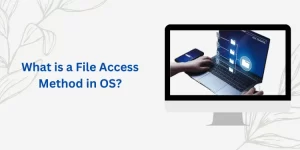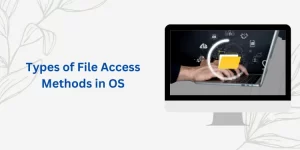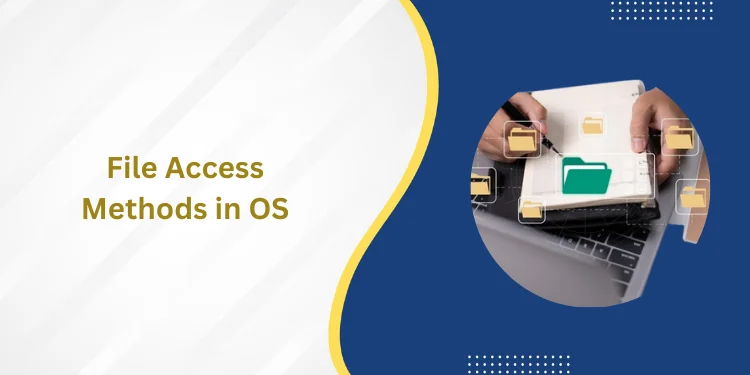Table of Contents
ToggleIntroduction
Files comprehend a lot of information required by the system. File Access Methods in OS, The computer memory may require specific files during execution. We need very efficient methods to retrieve the data by accessing the files in the least time possible.
File access methods are needed to read and write data to and from files efficiently. Each method has advantages and disadvantages, and the method option depends on the application’s specific needs. Using an appropriate file access method can improve the performance and efficiency of an application.
What is File Access?

A file access definition can control access to data in specified tables and columns or tables and columns for which access is not granted explicitly. You define access permissions by creating an access list for a table, column, or the default.
What are the File Access Permissions?
File permissions control what user can perform which actions on a file. File permissions form a significant part of a resistance strategy. In public systems, only part of the system is shared. The system files, at least, need to be protected from wanton modification by attackers.
Why are File Permissions Used?

File permissions identify who and what can read, write, modify, and access them. This is major, as the Codex describes, since WordPress may require access to write to files in your wp-content index to qualify certain functions.
Click here to know about data analyst : Data Analyst Course in Bangalore
What is a File Access Method in OS?

The file access methods in os are sequential access, direct access, and indexed sequential access. Sequential access allows access to the file records in sequential order, one after the other.
Direct access method in file access methods in os allows random access to the file blocks. Indexed sequential access is a modification of the sequential access method in file access methods in os.
Types of File Access Methods in OS

When we access the data inside the file, it needs to be read into the memory before further execution is done. There are specific ways in which the information inside a file handling can be accessed.
There are different types of file access methods in OS mentioned below
Sequences Method
This is the most common file access methods in OS. The details in the file are processed in order, one record after the other. All the data must be loaded sequentially for random access inside the given file. Usually, it contains read, write, and rewind file operations.
The read operation (read next) reads the data stored on the next position of the pointer and moves the information forward by one read point. File Access Methods in OS, The write operation (write next) adds the data at the end of the file and moves the pointer forward to the newly registered data.
The rewind operation moves the pointer backward until the file’s required information appears. An example of this file access method can be accessing data from a tape.
Analysis of the sequential access method
- It takes effort to implement. The work is similar to a linked list.
- Since the records cannot be randomly accessed, it could be more efficient.
- It is a slow method.
Advantages of the Sequential Method :
- It is simple to appliance this file access mechanism.
- It uses lexicographic order to access the next entry quickly.
- Simple and easy to implement, requiring minimal hardware and software support.
- Low cost, as it doesn’t require complex indexing or search algorithms.
Disadvantages of the Sequential Method :
- If the file data that requires to be accessed following is not present next to the ongoing document, this type of file access method is slow.
- Moving a sizable file block may be necessary to insert a new record.
- More efficient for random access: Sequential access could be more efficient for randomly accessing data within a file, as it requires searching the entire file to find the desired data.
- Limited concurrency: Concurrent access to a sequential file can be challenging, as only one process can access the file simultaneously.
Also read about: Data Science Course in Nagpur
Direct
The direct method in file access methods in os is also known as the relative access method. A file is composed of fixed-length logical records called blocks. These blocks can be accessed in any order. The file is accessed as a numbered sequence of blocks or logs. Therefore, we may read block 10, then block 40, and then write block 5.
There are no constraints on the order of reading or writing for a direct-access file. Direct access files in file access methods in os are of great use for intermediate access to large amounts of information, and most databases are based on this type of file access.
Analysis of the direct access method
- Faster than the sequential access method in file access methods in os.
- Allows random access. Therefore there is no need to traverse all the blocks.
- Implementation is easy.
Advantages of Direct/Relative Access:
- The files can be retrieved right away with direct access mechanism, reducing the average access time of a file.
- There is no need to traverse all the blocks before the required block to access the record.
- Suitable for real-time systems that require fast and predictable data access.
- Flexible data retrieval, ideal for accessing data in a non-sequential fashion.
Disadvantages of Direct/Relative Access:
- The direct access mechanism is typically challenging to implement due to its complexity.
- Organizations can face security issues due to direct access, as the users may access/modify sensitive information. As a result, additional security processes must be put in place.
- The direct access methods in file access methods in os take lots of time.
Indexed Method
A direct-access method in file access methods in os is the foundation for this file access technique. An index method in file access methods in os is created for the entire file, which contains pointers to the various blocks inside the disk.
To find data in the file, we first traverse through the index and then use the information to access the file directly. File Access Methods in OS, However, in this file access, extra memory is required for keeping the index file, which burdens the memory resources.
Analysis of the indexed method
- It is a modification of the sequential access method in file access methods in os. It allows random access.
- Apart from the file records, a different index is required to keep track of the blocks.
- If file size increases, the index may be unable to hold all the pointers due to memory constraints. Hence in such a case multi-level index may be used.
Advantages of Indexed Sequential Access:
- If the index table is appropriately arranged, it quickly accesses the records.
- Records can be added at any position in the file soon.
Disadvantages of Indexed Sequential Access:
- Compared to other file access methods, it is costly and less efficient.
- It wants additional storage space.
Conclusion
- The Operating system may require specific files to be loaded into the computer memory.
- The file access methods in os are sequential access, direct access, and indexed sequential access.
- Sequential access allows access to the file records in sequential order, one after the other.
- Direct access method in file access methods in os allows random access to the file blocks.
- Indexed sequential access is a modification of sequential access. It contains an index that holds pointers to various other file blocks.
Frequently Asked Questions (FAQs)
What is file access permission in OS?
File access control is assigning or restricting user access to specific files. It ensures that sufficient information is provided for authorized users but is kept safe from malicious intruders attempting to launch file-based attacks or instigate data breach incidents.
What are file protection methods?
File security protects files and ensures that only authorized users can access them. This can include setting strong passwords, encrypting files, and implementing access controls.
Windows File Protection (WFP) prevents programs from replacing critical Windows system files. Programs must not overwrite these files because the operating system and other programs use them. Protecting these files prevents problems with programs and the operating system.
What is sequential vs. direct access?
Direct access means not having to search subsequent orders through the data. With sequential access, data is accessed by starting at one location and then going through the following areas until the data is found.
Sequential obtain increases interaction cost: the user has to inspect all the items that precede the object of interest in a list. With direct acquisition, the user can focus on the element of interest without explicitly processing the things that come before it in the list.
What are sequential access and random access?
Sequential access memory is a data storage device class that reads stored data sequentially. This contrasts with random access memory, where data can be acquired in any order. Sequential obtain devices are usually a form of magnetic storage or optical storage.
The significant variation between sequential and random writing is how we write the data in the memory. As we discussed, we can start writing data at the beginning of the memory following an order using sequential writing.
What is the random access method?
Random access method in file access methods in os is the ability to obtain an arbitrary sequence element in equal time or any datum from a population of addressable elements roughly as quickly and efficiently as any other, no matter how many aspects may be in the set.













